Article by: Rocky T. McKenzie © 2014
This write up is to show how to swap in an Explorer 8.8 rear end into a Ranger without welding. The Explorer rear end swap is pretty common for Ranger enthusiasts, but most guys are welding on new shock mounts and spring perches to keep the truck in its original configuration. The method below is completely bolt in and will lower the rear of the truck roughly 4 inches from stock while also giving you firmer springs.
My motivation for writing this is that when I was planning this swap I was unable to find all of this information in one place. In addition there is a lot of bad info out there, with people being told this is not possible, or being told that it is possible but with the wrong parts.
The truck I am working on is a 1998 Ford Ranger 2wd Supercab. It is equipped with a 2.5l 4 cylinder engine, a manual transmission and a 7.5 rear end with an open differential. The Explorer rear end came from a junkyard, it is supposed to have come from a 1998 Ford Explorer with a 6 cylinder. Other years and models may be equipped differently, so your experience may well be different from mine.
That said this was my first major mechanical swap in a vehicle and it went very smoothly.
This is not a picture heavy write up. I simply did not take pictures while I was doing the work and almost all of the pictures you need can be found elsewhere. I am not a mechanic and I take no responsibility for your actions. Please make sure you understand what you are doing before you modify your vehicle.
What you gain:
- Stronger rear end, capable of holding more power
- Stiffer leaf springs for better handling
- 4 Inch drop in the rear
- Disk Brakes
- Limited slip, depending on what you have in your truck now
- A slightly wider rear end, the Explorer rear end is a little bit wider depending on the year.
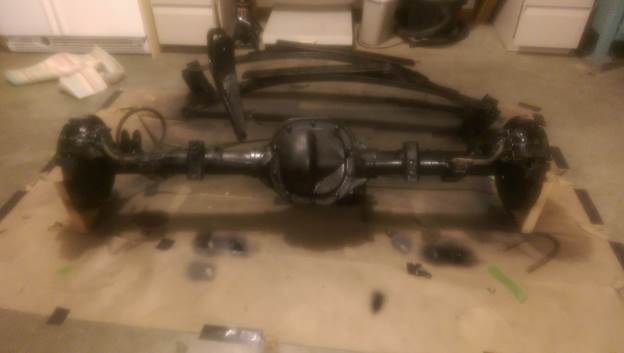
(Explorer 8.8 and leaf springs, painted and ready to install)
What you need:
An Explorer 8.8 rear end. Preferably in the same gear ratio as you have now. If you are changing gear ratios your speedometer will be wrong. Get as much as you can with the axle so you are not scrambling to find parts. The yard I bought from was good in cutting the brake hoses and parking brake cable far enough forward that they were still usable. Older ones will have drum brakes; I think 1996 and up will have the disc brakes.
Explorer U Bolts for the 8.8. The stock Ranger ones from a 7.5 will not work.
Explorer Leaf Springs. If you use the stock Ranger springs you will get more like a 6 inch drop. Using the Explorer springs gets you the firmer ride and doesn’t drop you as low. Make sure you get springs out of a 4 door Explorer, the two door Sport model uses a different spring that will not work for this swap.
Explorer rear Parking brake cables. Should work with the Ranger setup, mine is currently not tensioned correctly, but I am still working on it. Full disclosure, mine did not work before this swap. I took it to a Ford dealer to have them check out noise in the old rear end and their “diagnostics” resulted in my park brake no longer working.
Explorer driver side U Bolt Plates/ Shock Mounts (2). This is the trick, and also a source of bad information on the internet. The Ranger has the passenger shock in front of the axle and the Explorer mounts them both behind the axle. The Explorer shock mount for the driver’s side works perfectly, and a second driver’s side mount rotated the opposite direction works perfectly for the Ranger’s passenger side. The Ubolt Plate/ Shock mount for the Explorer is a single part, and you need two of them, both from the driver’s side. I obtained one with my junkyard Explorer rear end, and bought the other at Ford, the cost was about $35. (Ford Part number F57Z-5798-AE)
Brake Pads and brake fluid. We are taking part of the brake system apart, so why not change the brake pads while we are in here.
Tools needed:
Basic hand tools, wrenches, sockets and a ratchet etc. The bolts for the leaf springs are quite large, so make sure you have a couple of sockets large enough to fit them before you get started.
Angle Grinder. This will only be needed if you have trouble removing your old leaf springs. I needed a 7 Inch grinder to cut the bolt on mine, a smaller 4 inch grinder did not have enough reach to cut the bolts easily.
Before you start:
Take a can of your choice of penetrating oil out the day before and oil everything you will be removing. I neglected to do this and it cost me quite a bit of time.
The Swap:
Break your lug nuts loose on the rear wheels. Use blocks at the front to keep the truck from rolling. Jack up the rear of your truck one side at a time and place it on jack stands for safety. I placed my jack stands at the point on the frame just before it kicks up, because my jack stands are not very tall.
Remove the rear wheels. Set them aside.
Remove the drums from your truck and disconnect the parking brakes. There are guides out there to do this properly, but we used a Dremel to cut the springs. My rear brakes had probably never been touched, and were in very rough shape with 230k on the truck’s odometer.
Disconnect the VSS sensor from the top of your axle. This just snaps into place, but it can be hard to get apart with the accumulated road grime.
Reach up to the frame on the driver’s side above the axle and disconnect the brake hose. There is also a clip on the top holding this in place.
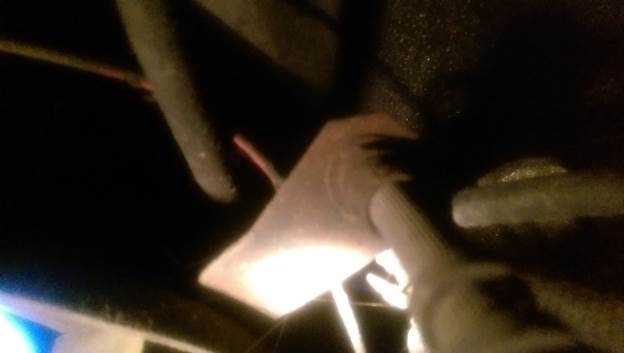
Disconnect the drive shaft. You can put the truck in gear to keep it from rotating on you. You will need to support it so it does not drop. Also wrap it in electrical tape so it does not come apart.
Remove the shocks by taking out the bolt that attaches them to the lower mounts.
Support your old axle so it does not fall and then remove the nuts and Ubolts on both sides. This should allow your axle to drop free. Make sure nothing is still connected to the axle and pull it out from under your truck. My friend and I had to move it back and forth to clear the spare tire, exhaust, and mud flaps.
Remove the bolt holding the leaf springs through the front hanger and the bolt holding it into the shackle. Make sure you support the leaf spring so it does not fall. A combination of rust and the old rubber bushing kept me from taking these bolts out. After struggling with them for a long time I carefully cut the bolts out with a 7 inch angle grinder and a cut off wheel. If you are forced to do this be very careful not to damage the front hanger or the shackle. I had planned to sell my old leaf springs, but I ended up grinding them up a bit while cutting out the bolts.
Once you have the leaf springs out you can start getting your new rear end under the truck. I’m not entirely sure that the process I used is the easiest way to assemble the Explorer rear end and leaf springs. I had an easy time with the passenger side, and a much harder time getting everything aligned on the driver’s side. If there is a trick to doing this more easily I hope someone else can contribute it.
Carefully move your Explorer 8.8 under your truck, and then slide the new leaf springs in under them. I then attached the rear of the passenger leaf spring to the shackle. Next I used a pair of jacks to lift the other side of the leaf spring and the axle up so that I could put the u bolts in through the U bolt plate to secure everything. Make sure you have your U bolt plate positioned so that the shock mount points in the correct direction to mount up to your shock. Next I used a jack to lift the front side of the leaf spring so that it was aligned with the front hanger. Make sure all your bolts are tight.
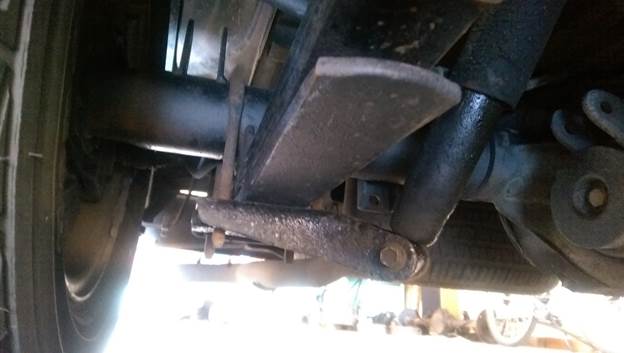
(Passenger’s side photographed from the front to show the shock mount)
Move to the driver’s side and do the same thing. I had a little bit of trouble getting the bolt through the shackle, and my shackle did not want to move at all to accommodate me. Once you have the bolt through the shackle side use a jack to support the leaf spring and put your U bolts through the mounting plate. Again, make sure your shock mount is pointed the right direction. Use your jack to position the leaf spring to get the final bolt in. I had a lot of trouble getting this to line up, but with careful positioning of the jack and a little muscle I got it to line up. Make sure you get the bracket for the parking brake on there; the leaf spring bolt holds that on as well.
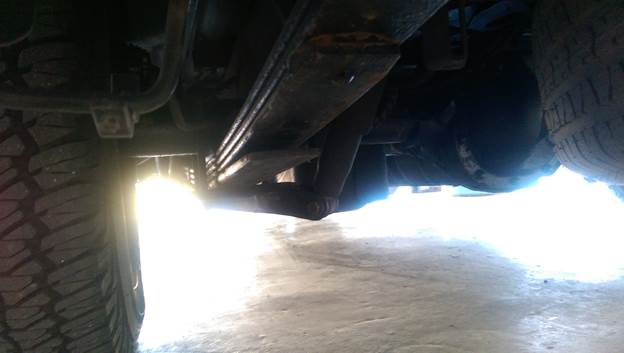
(Driver’s side photographed from the rear to show the shock mount)
Connect your drive shaft, plug your vss sensor into the new axle. Connect the Explorer brake hose at the same place you disconnected the old one. I had a very hard time getting this to connect, it is the correct size, the mount is just in a very bad place on the inside of the frame. It is very hard to see and not easy to get your hands up there.
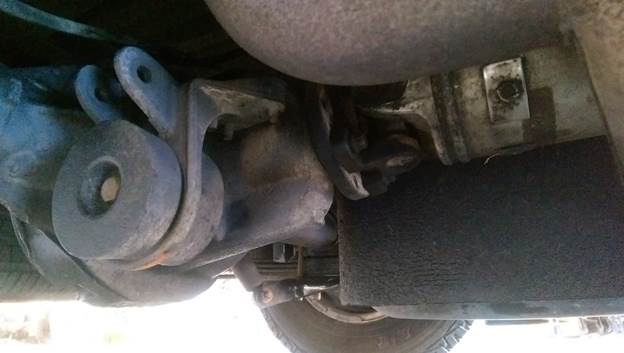
(Explorer Axle with the drive shaft connected)
Once you have everything else connected you need to attach your shocks. Each shock is held on by a single bolt that passes through the mount and the shock itself. You will have to compress your shock to get it to line up so you can put the bolt through.
The next step is attaching the new parking brake cable. Your Ranger cables should still be attached, pull them out and route the explorer cables in the same manner the old Ranger ones were mounted. There are a couple of connectors holding the rear brake cables to the front cable. Mine were corroded and even soaking in PB blaster and prying on them would not get them apart. I ended up using a Dremel cut off wheel to carefully cut the end of the Ranger cable apart without damaging the connector. I actually tried to just order a new connector from ford, but they insisted it was one piece and I would have to order the entire rear brake cable setup. The rear connector is a little easier to take off, there is a small tab holding the cable in, you can pry this with a screwdriver. The cable passes through a bracket by the leaf spring, I had to cut out the old ranger one. The Explorer cable should just push through the hole and click into place.
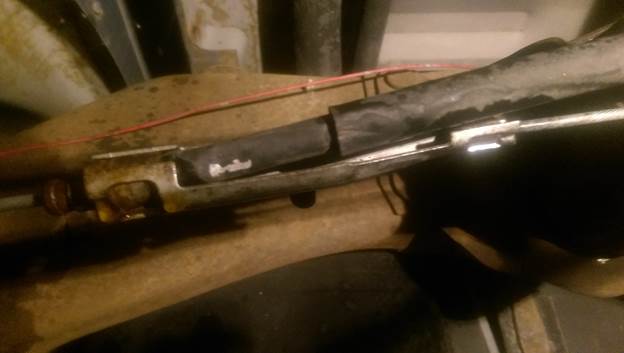
This is as far as I got with the parking brakes. The Explorer ones seem to be the same length or very close to the Ranger length and everything fit together perfectly apart from the corrosion issues. My parking brakes did not work before, and still do not. I think it is a tensioning issue that was present before the swap. Assuming yours work correctly you might want to read up on taking the tension off using the drill bit trick before you start working with them. I can’t offer any guidance on that because the Ford dealer broke mine.
(My current plan for the parking brakes is to try a universal parking brake cable adjuster, Dorman part number 03006.)
The last step before you are ready to go is to trim the rubber bump stops down on frame above the axle. You need to trim off enough to give your axle some room to move without constantly crashing into the bump stop. I trimmed about an inch off mine with a reciprocating saw. It cuts very easily. Make sure you do not cut it too deeply. The Explorer axle has a sway bar mount that sticks up above the center line of the axle and if you cut the bump stop short this mount could hit the frame.
I actually ran the truck for a day before I cut my bump stops down. The ride was very rough, every little bump in the road felt like the truck was bottoming out. Trimming the bump stop made the truck ride much smoother.
If you are doing a brake pad swap your next step would be to work on your brakes. If you are not changing pads you need to go ahead and bleed your brake system. I am not going to include the brake work in this write up because there are articles out there that are better than I would be able to write. Either way you need to bleed the brake system before you go any further.
Next you need to put your wheels and lug nuts back on, and lower the truck back to the ground. Don’t forget to tighten down the lug nuts after the truck is on the ground to ensure they are safe to drive on.
Article by: Rocky T. McKenzie ©2014
If you have any suggestions to update this article or wish to post this material elsewhere please contact forum member Druid318
